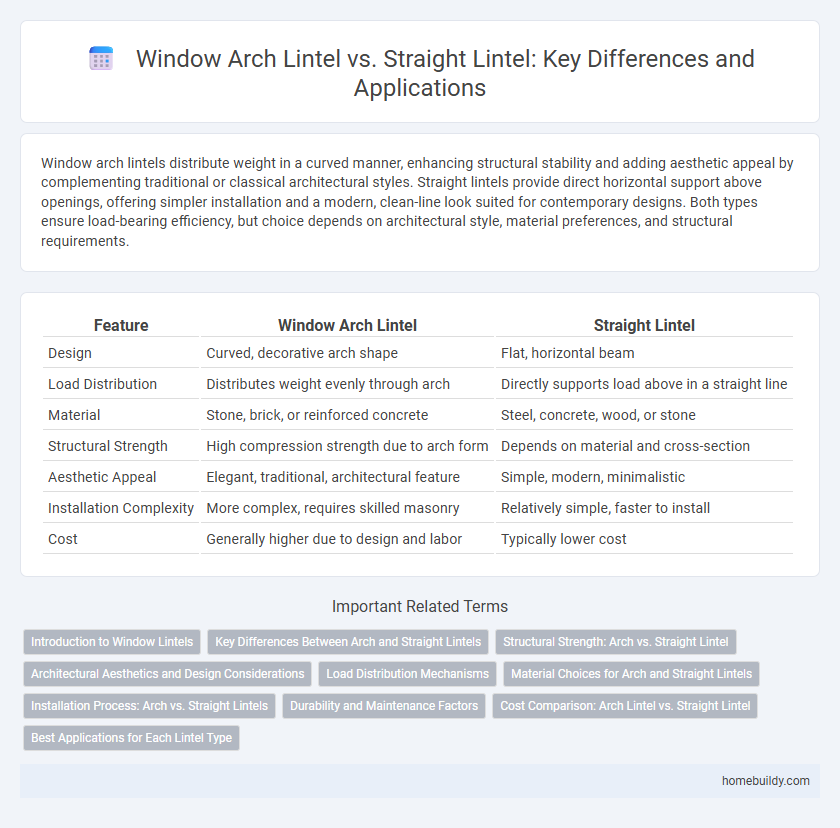Window arch lintels distribute weight in a curved manner, enhancing structural stability and adding aesthetic appeal by complementing traditional or classical architectural styles. Straight lintels provide direct horizontal support above openings, offering simpler installation and a modern, clean-line look suited for contemporary designs. Both types ensure load-bearing efficiency, but choice depends on architectural style, material preferences, and structural requirements.
Table of Comparison
| Feature | Window Arch Lintel | Straight Lintel |
|---|---|---|
| Design | Curved, decorative arch shape | Flat, horizontal beam |
| Load Distribution | Distributes weight evenly through arch | Directly supports load above in a straight line |
| Material | Stone, brick, or reinforced concrete | Steel, concrete, wood, or stone |
| Structural Strength | High compression strength due to arch form | Depends on material and cross-section |
| Aesthetic Appeal | Elegant, traditional, architectural feature | Simple, modern, minimalistic |
| Installation Complexity | More complex, requires skilled masonry | Relatively simple, faster to install |
| Cost | Generally higher due to design and labor | Typically lower cost |
Introduction to Window Lintels
Window lintels serve as crucial structural elements that support the load above window openings, preventing cracks and ensuring stability. Arch lintels distribute weight more evenly through their curved design, offering enhanced strength and aesthetic appeal in traditional architecture. Straight lintels, typically made from steel, concrete, or reinforced masonry, provide a simplified, cost-effective solution suited for modern construction where straight lines dominate.
Key Differences Between Arch and Straight Lintels
Window arch lintels distribute load more evenly by directing weight along curved paths, reducing stress points compared to straight lintels, which carry loads directly downward. Straight lintels are typically simpler and faster to construct, often made from reinforced concrete or steel, while arch lintels require precise masonry or specialized fabrication for their curved shape. The choice impacts architectural style, structural behavior, and material usage, with arches providing enhanced aesthetic appeal and greater load-bearing efficiency in specific applications.
Structural Strength: Arch vs. Straight Lintel
Window arch lintels distribute structural load more effectively by transferring forces along the curve to the supports, resulting in enhanced strength and stability. Straight lintels bear bending stresses directly, often requiring reinforcement such as steel or concrete to maintain structural integrity under heavy loads. Arch lintels excel in applications with wider openings due to their natural compression strength, whereas straight lintels are preferred for simpler, cost-effective construction with moderate load demands.
Architectural Aesthetics and Design Considerations
Window arch lintels enhance architectural aesthetics by introducing graceful curves that soften the visual profile of openings, often complementing classical and traditional design styles. Straight lintels offer a clean, minimalist look suited for modern or contemporary architectures, providing structural simplicity and ease of installation. Design considerations include the surrounding architectural context, material strength requirements, and desired visual impact, where arches distribute load more evenly but may require complex construction techniques compared to straight lintels.
Load Distribution Mechanisms
Window arch lintels distribute loads through a curved structure that transfers weight laterally to the supports, effectively reducing stress on the center of the opening. Straight lintels rely on bending resistance, where the load is carried directly downward, requiring stronger materials or additional reinforcement to prevent deflection. The arch lintel's design optimizes load path efficiency, making it suitable for heavier loads and wider openings compared to straight lintels.
Material Choices for Arch and Straight Lintels
Arch lintels typically utilize materials such as reinforced concrete, steel, and stone to effectively distribute loads through their curved design, enhancing structural integrity and aesthetic appeal. Straight lintels commonly employ steel, reinforced concrete, or timber, prioritizing strength and ease of installation in linear window frameworks. Material selection for both arch and straight lintels depends on factors like load-bearing requirements, architectural style, and environmental conditions.
Installation Process: Arch vs. Straight Lintels
Window arch lintels require precise shaping and support during installation to maintain the curved form, often involving custom formwork or pre-formed arches, whereas straight lintels are typically simpler to install with standard-sized steel or concrete beams placed horizontally above the window. Arch lintels demand careful load distribution to prevent structural weaknesses around the curve, in contrast to straight lintels which transfer load directly downwards in a linear path. Both installation processes must ensure proper anchoring into the surrounding masonry, but arch lintels often necessitate additional skilled labor and time due to their complex geometry.
Durability and Maintenance Factors
Window arch lintels offer enhanced durability due to their curved design, which more effectively distributes load and reduces stress concentrations compared to straight lintels. Maintenance requirements for arch lintels are generally lower because their shape minimizes cracking and structural weaknesses over time. Straight lintels may require more frequent inspections and repairs due to potential stress points causing material fatigue and damage.
Cost Comparison: Arch Lintel vs. Straight Lintel
Arch lintels generally incur higher costs than straight lintels due to their complex design and the specialized labor required for installation. Materials for arch lintels must often be custom-fabricated or shaped, increasing both time and expense compared to the simpler, standardized straight lintels. Budget considerations typically favor straight lintels for cost efficiency in residential and commercial construction projects.
Best Applications for Each Lintel Type
Window arch lintels excel in aesthetic appeal and load distribution, making them ideal for traditional or heritage buildings where style and structural integrity are paramount. Straight lintels provide efficient, cost-effective support for modern constructions with rectangular openings, perfectly suited for standardized window designs. Choosing between an arch or straight lintel depends on architectural style, material availability, and the specific loading requirements of the window opening.
window arch lintel vs straight lintel Infographic

 homebuildy.com
homebuildy.com